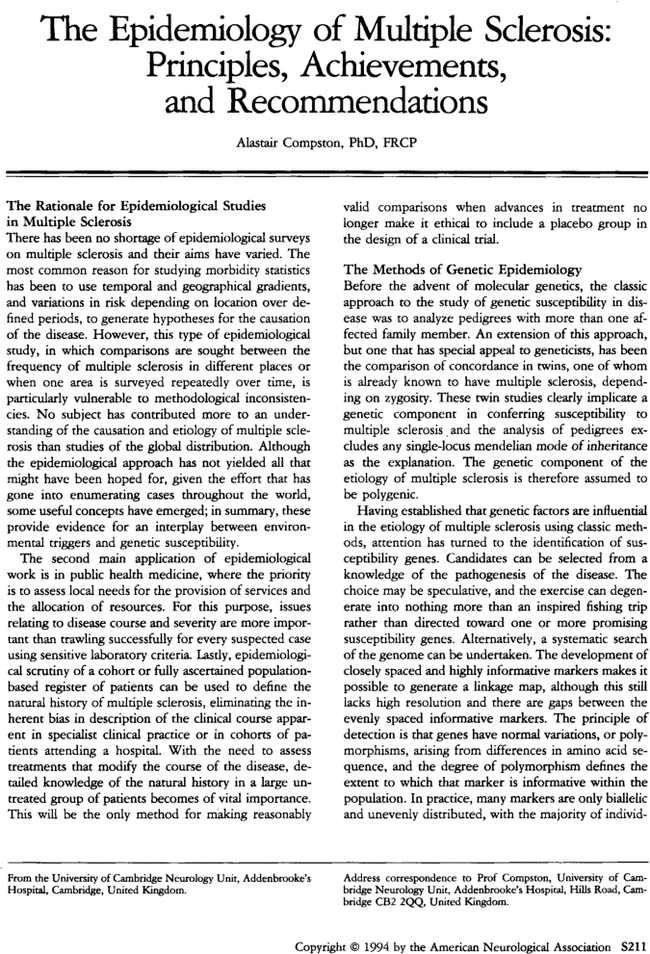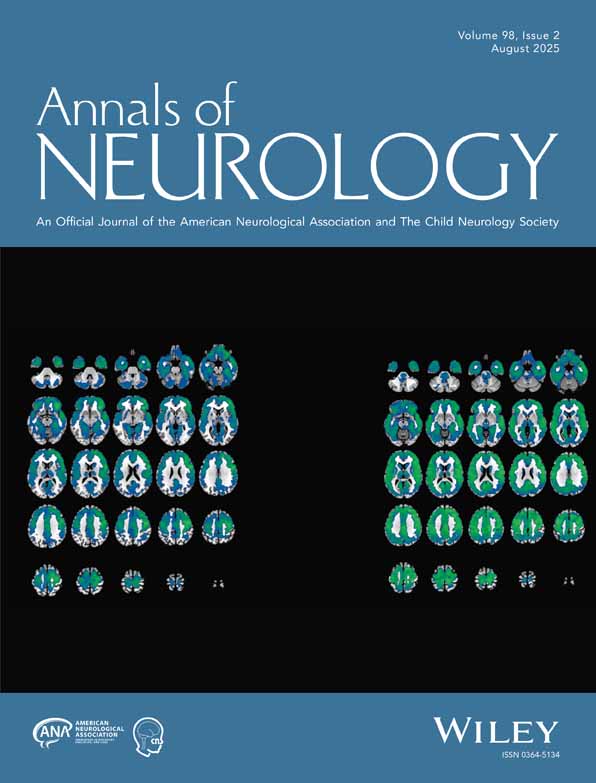Article
Full Access
The epidemiology of multiple sclerosis: Principles, achievements, and recommendations
Prof Alastair Compston PhD, FRCP,
Corresponding Author
Prof Alastair Compston PhD, FRCP
University of Cambridge Neurology Unit, Addenbrooke's Hospital, Cambridge, United Kingdom
University of Cambridge Neurology Unit, Addenbrooke's Hospital, Hills Road, Cambridge CB2 2QQ, United KingdomSearch for more papers by this authorProf Alastair Compston PhD, FRCP,
Corresponding Author
Prof Alastair Compston PhD, FRCP
University of Cambridge Neurology Unit, Addenbrooke's Hospital, Cambridge, United Kingdom
University of Cambridge Neurology Unit, Addenbrooke's Hospital, Hills Road, Cambridge CB2 2QQ, United KingdomSearch for more papers by this author
References
- 1 Poskanzer DC, Terasaki PI, Prenney LP, et al. Multiple sclerosis in the Orkney and Shetland Islands. III. Histocompatibility determinants. J Epidemiol Community Health 1980; 34: 253–257
- 2 Compston DAS. Multiple sclerosis in the Orkneys. Lancet 1981; 2: 98
- 3 Risch N. Linkage strategies for genetically complex traits: the power of affected relative pairs. Am J Hum Genet 1990; 46: 229–241
- 4 Risch N. Linkage strategies for genetically complex traits. III. The effect of marker polymorphism on the analysis of affected relative pairs. Am J Hum Genet 1990; 46: 242–253
- 5 Holmans P. Asymptotic properties of affected sib-pair linkage analysis. Am J Hum Genet 1993; 52: 362–374
- 6 Davenport CB. Multiple sclerosis from the standpoint of geographic distribution and race. Arch Neurol 1922; 8: 51–58
- 7 Limburg CC. The geographic distribution of multiple sclerosis and its estimated prevalence in the United States. Proc Assoc Res Nerv Ment Dis 1950; 28: 15–24
- 8 Kurtzke JF. A reassessment of the distribution of multiple sclerosis. Part one. Acta Neurol Scand 1975; 51: 110–136
- 9 Kurtzke JF. A reassessment of the distribution of multiple sclerosis. Part two. Acta Neurol Scand 1975; 51: 137–157
- 10 Kurtzke JF. Epidemiologic evidence for multiple sclerosis as an infection. Clin Microbiol Rev 1993; 6: 382–427
- 11 Sutherland JM. Observations on the prevalence of multiple sclerosis in northern Scotland. Brain 1956; 79: 635–654
- 12 Compston DAS, Ebers GC. The genetics of multiple sclerosis. In: SD Cook, ed. Handbook of neurology. New York: Decker, 1990: 25–39
- 13 Hammond SR, McLepd JG, Millingen KS, et al. The epidemiology of multiple sclerosis in 3 Australian cities: Perth, Newcastle and Hobart. Brain 1988; 111: 1–25
- 14 Miller DH, Hammond SR, McCloud JG, Skegg DCG. Multiple sclerosis in Australia and New Zealand: are the determinants genetic or environmental? J Neurol Neurosurg Psychiatry 1988; 53: 903–905
- 15 Elian M, Dean G, Nightingale S. Multiple sclerosis among United Kingdom born children of immigrants from the Indian subcontinent, Africa and the West Indies. J Neurol Neurosurg Psychiatry 1990; 53: 906–911
- 16 Sadovnick AD, Baird PA, Ward RH. Multiple sclerosis; updated risks for relatives. Am J Med Genet 1988; 29: 533–541
- 17 Ebers GC, Bulman DE, Sadovnick AD, et al. A population based study of multiple sclerosis in twins. N Engl J Med 1986; 315: 1638–1642
- 18 Sadovnick AD, Armstrong H, Rice GPA, et al. A population-based study of multiple sclerosis in twins: update. Ann Neurol 1992; 33: 281–285
- 19 Mumford C, Wood N, Kellar-Wood H, et al. The British Isles Survey of Multiple Sclerosis in twins. Neurology 1994; 44: 11–15
- 20 Thorpe J, Mumford CJ, Miller DH, et al. The British Isles study of multiple sclerosis in twins; magnetic resonance imaging. J Neurol Neurosurg Psychiatry 1994; 57: 491–496
- 21 French Research Group on Multiple Sclerosis. Multiple sclerosis in 54 twinships: concordance rate is independent of zygosity. Ann Neurol 1992; 32: 724–727
- 22 Spurkland A, Ronningen KS, Vandvik B, et al. HLA-DQA1 and HLA-DQB1 genes may jointly determine susceptibility to develop multiple sclerosis. Hum Immunol 1991; 30: 69–75
- 23 Hillert J, Olerup O. Multiple sclerosis is associated with genes within or close to the HLA-DR-DQ sub-region on a normal DR15 DQ6, Dw2 haplotype. Neurology 1993; 43: 163–168
- 24 Haegert D, Francis GS. HLA-DQ polymorphisms do not explain HLA class II associations with multiple sclerosis in two Canadian patient groups. Neurology 1993; 43: 1207–1210
- 25 Ebers GC, Paty DW, Stiller CR, et al. HLA typing in multiple sclerosis sibling pairs. Lancet 1982; 1: 88–90
- 26 Bulman DE, Armstrong H, Ebers GC. Allele frequencies of the third component of complement (C3) in MS patients. J Neurol Neurosurg Psychiatry 1991; 54: 554–555
- 27 Liblau R, van Endert P, Sandberg-Woolheim M, et al. Antigen processing gene polymorphisms in HLA-DR2 multiple sclerosis. Neurology 1993; 43: 1192–1197
- 28 Kellar-Wood H, Powys S, Gray J, Compston DAS. MHC encoded TAP1 and TAP2 dimorphisms in multiple sclerosis. Tissue Antigens 1994; 43: 129–132
- 29 Olerup O, Hillert J. HLA class II-associated genetic susceptibilty in multiple sclerosis: a critical evaluation. Tissue Antigens 1991; 38: 1–15
- 30 Kurdi A, Abdallat A, Ayesh I, et al. Different B Lymphocyte alloantigens associated with multiple sclerosis in Arabs and northern Europeans. Lancet 1977; 1: 1123–1125
- 31 Marrosu MG, Muntoni F, Murru MR, et al. Sardinian multiple sclerosis is associated with HLA-DR4: a serologic and molecular analysis. Neurology 1988; 38: 1749–1753
- 32 Olerup O, Hillert J, Fredrikson S, et al. Primarily chronic progressive and relapsing/remitting multiple sclerosis: two immunogenetically distinct disease entities. Proc Natl Acad Sci USA 1989; 86: 7113–7117
- 33 Martell M, Marcadet A, Strominger J, et al. T cell receptor alpha genes might be involved in multiple sclerosis genetic susceptibility. CR Acad Sci 1987; 304: 105–110
- 34 Oksenberg JR, Gaiser CN, Cavalli-Sforza L, Steinman L. Polymorphic markers of human T cell receptor alpha and beta genes. Family studies and comparison of frequencies in healthy individuals and patients with multiple sclerosis and myasthenia gravis. Hum Immunol 1988; 22: 111–121
- 35 Seboun E, Robinson MA, Doolittle TH, et al. A susceptibility locus for multiple sclerosis is linked to the T cell receptor beta chain complex. Cell 1989; 57: 1095–1100
- 36 Oksenberg JR, Sherritt M, Begovich AB, et al. T cell receptor V alpha and C alpha alleles associated with multiple sclerosis and myasthenia gravis. Proc Natl Acad Sci USA 1989; 86: 988–992
- 37 Beall SS, Concannon P, Charmley P, et al. The germline repertoire of T cell receptor beta chain genes in patients with chronic progressive multiple sclerosis. J Neuroimmunol 1989: 21: 59–66
- 38 Fugger L, Sandberg-Wollheim M, Morling N, et al. The germline repertoire of T-cell receptor beta chain genes in patients with relapsing remitting multiple sclerosis or optic neuritis. Immunogenetics 1991; 31: 278–280
- 39 Charmley P, Beall SS, Concannon P, et al. Further localisation of a multiple sclerosis susceptibility gene on chromosome 7q using a new T cell receptor beta-chain DNA polymorphism. J Neuroimmunol 1991; 32: 231–241
- 40 Hillert J, Leng C, Olerup O. No association with germline T cell receptor beta chain alleles or haplotypes in Swedish patients with multiple sclerosis. J Neuroimmunol 1991; 31: 141–147
- 41 Lynch SG, Rose JW, Petagan JH, et al. Discordance of the T-cell receptor alpha-chain gene in familial multiple sclerosis. Ann Neurol 1991; 30: 402–410
- 42 Lynch SG, Rose JW, Petagan JH, et al. Discordance of the T-cell receptor alpha-chain gene in familial multiple sclerosis. Neurology 1992; 42: 839–844
- 43 Hillert J, Leng C, Olerup O. T-cell receptor alpha-chain gene germline polymorphisms in multiple sclerosis. Neurology 1992; 42: 80–84
- 44 Hashimoto LL, Mak T, Ebers GC. T-cell receptor alpha-chain polymorphisms in multiple sclerosis. J Neuroimmunol 1992; 40: 41–48
- 45 Martinez-Naves E, Victoria-Gutierrez M, Lopez-Larrea C. The germline repertoire of T cell receptor beta chain genes in multiple sclerosis patients from Spain. J Neuroimmunol 1993; 47: 9–14
- 46 Foli M, Wood NW, Kellar-Wood HF, et al. No linkage between multiple sclerosis and the T cell receptor alpha chain locus. J Neurol Sci 1994; 124: 32–37
- 47 Pandey JP, Goust JM, Salier JP. Immunoglobulin G heavy chain (Gm) allotypes in multiple sclerosis. J Clin Invest 1981; 67: 1797–1800
- 48 Propert DN, Bernard CCA, Simons MJ. Gm allotypes in multiple sclerosis. J Immunogenet 1982; 9: 359–361
- 49 Salier J-P, Sesboue R, Martin-Mondiere C, et al. Combined influence of Gm and HLA phenotypes upon multiple sclerosis susceptibility and severity. J Clin Invest 1986; 78: 533–538
- 50 Gaiser CN, Johnson MJ, De Lange G, et al. Susceptibility to multiple sclerosis associated with an immunoglobulin gamma 3 restriction length polymorphism. J Clin Invest 1987; 79: 309–313
- 51 Walter MA, Gibson WT, Ebers GC, Cox DW. Susceptibility to multiple sclerosis is associated with the proximal immunoglobulin heavy chain region. J Clin Invest 1991; 87: 1266–1273
- 52 Hashimoto L, Walter M, Cox D, Ebers GC. Immunoglobulin heavy chain variable region polymorphisms in multiple sclerosis susceptibility. J Neuroimmunol 1993; 44: 77–84
- 53 Hillert J. Immunoglobulin constant region gene polymorphisms in multiple sclerosis. J Neuroimmunol 1993; 43: 9–14
- 54 Boylan K, Takahashi N, Paty D, et al. DNA length polymorphism 5′ to the myelin basic protein gene is associated with multiple sclerosis. Ann Neurol 1990; 27: 291–297
- 55 Tienari P, Wikstrom J, Sajantila A, et al. Genetic susceptibility to multiple sclerosis linked to myelin basic protein gene. Lancet 1993; 340: 987–991
- 56 Rose J, Gerken S, Lynch S, et al. Genetic susceptibility in familial multiple sclerosis not linked to the myelin basic protein gene. Lancet 1993; 341: 1179–1181
- 57 Graham C, Kirk C, Nevin N, et al. Lack of association between myelin basic protein gene microsatellite and multiple sclerosis. Lancet 1993; 341: 1596
- 58 Wood NW, Holmans P, Clayton D, et al. No linkage or association between multiple sclerosis and the myelin basic protein gene in affected sibling pairs. J Neurol Neurosurg Psychiatry 1994; 57: 1191–1194
- 59 Weinshenker BG, Bass B, Rice GPA, et al. The natural history of multiple sclerosis: a geographically based study. 1. Clinical course and disability. Brain 1989; 112: 133–146
- 60 Svenningsson A, Runmarker B, Lycke J, Andersen O. Incidence of MS during two fifteen-year periods in the Gothenburg region of Sweden. Acta Neurol Scand 1990; 82: 161–168
- 61 Weinshenker BG, Rice GPA, Noseworthy J, et al. The natural history of multiple sclerosis: a geographically based study. 3. Multivariate analysis of predictive factors and models of outcome. Brain 1991; 114: 1045–1056
- 62 Runmarker B, Andersson C, Prognostic factors in a multiple sclerosis incidence cohort with 25 years of follow-up. Brain 1993; 116: 117–134
- 63 Runmarker B, Andersson C, Oden A, Andersen O. Prediction of outcome in multiple sclerosis based on multivariate models. J Neurol 1994; 241: 597–604
- 64 Rizzo JF, Lessell S. Risk of developing multiple sclerosis after uncomplicated optic neuritis: a long term prospective study. Neurology 1988; 38: 185–190
- 65 Sandberg-Wollheim S, Bynke H, Cronqvist S, et al. A long term prospective study of optic neuritis: evaluation of risk factors. Ann Neurol 1990; 27: 386–393
- 66 Weinshenker B, Bulman D, Carriere W, et al. A comparison of sporadic and familial multiple sclerosis. Neurology 1990; 40: 1354–1358




